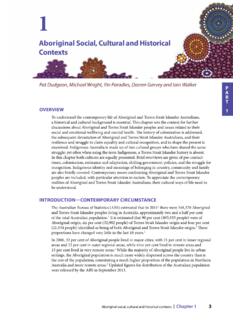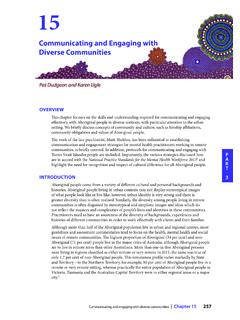Transcription of Aboriginal and Torres Strait Islander Social and Emotional ...
1 4. Aboriginal and Torres Strait Islander Social and Emotional Wellbeing Graham Gee, Pat Dudgeon, Clinton Schultz, Amanda Hart and Kerrie Kelly P. A. R. T. OVERVIEW 1. This chapter examines understandings of Social and Emotional wellbeing (SEWB) with the aim of clarifying the relationship between SEWB, mental health and mental health disorders from an Aboriginal and Torres Strait Islanders' perspective. The chapter begins with a brief historical overview of how the term Social and Emotional wellbeing' emerged as a signifier of Aboriginal and Torres Strait Islander concepts of health . We define SEWB as a multidimensional concept of health that includes mental health , but which also encompasses domains of health and wellbeing such as connection to land or country', culture, spirituality, ancestry, family, and The domains and guiding principles that typically characterise SEWB are outlined and situated within a framework that places Aboriginal and Torres Strait Islander world views and culture as central.
2 The importance of recognising Social , cultural, historical and political determinants in shaping Aboriginal and Torres Strait Islander SEWB is also discussed. We suggest that working within a SEWB framework involves developing an understanding of how these principles, domains and determinants manifest and operate at a local level, and explore how to apply these in a practical setting. INTRODUCTION. health and wellbeing are complex concepts and there is no clear consensus across or within cultures as to how these constructs should be , 3 Policy makers, researchers and practitioners working to improve the SEWB and mental health of Aboriginal and Torres Strait Islander peoples in Australia have to grapple with the task of defining these health concepts in terms that are relevant and consistent with Aboriginal and Torres Strait Islander understandings and experiences.
3 The linguistic and cultural diversity that exists within Aboriginal and Torres Strait Islander cultures needs to be acknowledged from the outset, as there are significant differences in the way SEWB, mental health and mental health disorders are understood within different Aboriginal and Torres Strait Islander communities across Australia. Similarly, the variation in other Australian understandings of what constitutes mental health and mental health disorder also needs to be recognised. SEWB WITHIN Aboriginal AND Torres Strait Islander CONTEXTS. The World health Organisation's (WHO's) Alma Ata Declaration on Primary health Care (1978)4 signalled a shift in thinking about health that mobilised a movement to tackle politically, socially and economically unacceptable' health inequalities through the delivery of comprehensive primary health At the time, these global shifts in approach to health care were seen to be consistent with the views of Aboriginal people and the establishment of Aboriginal and Torres Strait Islander Social and Emotional wellbeing | Chapter 4 55.
4 Aboriginal Community Controlled health Organisations (ACCHOs) that began in the 1970s. The uptake of the term SEWB' to reflect holistic Aboriginal and Torres Strait Islander concepts of health can be traced to the early efforts of these organisations to define health from an Aboriginal perspective. In 1979, the National Aboriginal and Islander health Organisation (now the National Aboriginal Community Controlled health Organisation) adopted the following definition of health : Aboriginal health does not mean the physical wellbeing of an individual, but refers to the Social , Emotional , and cultural wellbeing of the whole community. For Aboriginal people this is seen in terms of the whole-life-view. health care services should strive to achieve the state where every individual is able to achieve their full potential as human beings, and must bring about the total wellbeing of their communities.
5 This definition was used in the first National Aboriginal health Strategy (NAHS).5 In the section devoted to mental health , the NAHS Working Party held a strong line, arguing that mental health services are designed and controlled by the dominant society for the dominant society' and that the health system had failed to recognise or adapt programs to Aboriginal beliefs or law, causing a huge gap between service provider and user'.5 One of the strategy's key recommendations was for a health framework to be developed by Aboriginal and Torres Strait Islander peoples that recognised the importance of culture and history, and which defined health and illness from an Aboriginal and Torres Strait Islander perspective. The Royal Commission Into Aboriginal Deaths In Custody (RCIADIC)6 closely followed the release of the NAHS (1989),5 and implementation of the strategy was one of the commission's recommendations, as was the need for a national consultancy on Aboriginal and Torres Strait Islander mental health .
6 The latter culminated in the landmark Ways Forward National Consultancy Report on Aboriginal and Torres Strait Islander mental As detailed by Zubrick and colleagues in Chapter 5, the subsequent national efforts for policy reform led to the development of successive national action plans and frameworks, including the most recent National Strategic Framework for Aboriginal and Torres Straits Islander People's mental health and Social and Emotional Well Being 2004-09 (hereafter referred to as the 2004 SEWB. framework).1 Though now defunct, and with current efforts underway to renew this framework, it remains the guiding national document for defining Aboriginal and Torres Straits Islander - specific understandings of SEWB. Despite the limited implementation of past action plans and frameworks, the development of the SEWB concept at a nationwide level has been important to the process of reclaiming and renewing Aboriginal and Torres Strait Islander understandings of health and wellbeing, and legitimising and disseminating these understandings within the current health policy , 9.
7 DEFINING SEWB AND mental health . The synergies with Aboriginal and Torres Strait Islander mental health reform and the development and advocacy of SEWB as a guiding health concept have not necessarily translated into a clear and concise conceptualisation of the differences in understandings of SEWB and mental health , nor widespread agreement about how these concepts ought to coexist or intersect at the level of theory and ,11. Most of the Aboriginal and Torres Strait Islander SEWB and mental health literature draws upon the NAHS (1989)5 or the Ways Forward report (1995)7 to adopt a broad, holistic definition of health and , 13 Beyond that, as supported in the literature there is some divergence in understanding of the terms Social and Emotional wellbeing' and mental health ' and what they mean. In some of the literature the terms have been used interchangeably, either as an attempt to subvert the stigma associated with mental illness or to try and move away from biomedical perspectives of mental health and mental , 15 Kelly and colleagues16 suggest that the term SEWB signifies an Aboriginal and Torres Strait Islander concept of wellbeing that differs in important ways to Western concepts of mental health .
8 We suggest that, within the Aboriginal and Torres Strait Islander SEWB and mental health landscape, SEWB signifies a relatively distinct set 56 Working Together | Aboriginal and Torres Strait Islander mental health and wellbeing principles and practice of wellbeing domains and principles, and an increasingly documented set of culturally informed practices that differ in important ways with how the term is understood and used within Western health discourse, discussed in Chapter 6 (Zubrick and colleagues) and Guiding Principles of Social and Emotional Wellbeing The 2004 SEWB framework1 sets out nine guiding principles that were developed during the Ways Forward national consultancy7. These guiding principles shape the SEWB concept and describe a number of core Aboriginal and Torres Strait Islander cultural values that are detailed on page xxiv.
9 Nine guiding principles that underpin SEWB. 1. health as holistic P. 2. The right to self-determination A. R. 3. The need for cultural understanding T. 4. The impact of history in trauma and loss 5. Recognition of human rights 1. 6. The impact of racism and stigma 7. Recognition of the centrality of kinship 8. Recognition of cultural diversity 9. Recognition of Aboriginal strengths Created by SHRG,1 adapted from Swan and Raphael7. Cultural Domains of Social and Emotional Wellbeing Members of the Australian Indigenous Psychologists Association (AIPA) have endeavoured to link some of these areas of SEWB in a way that has utility for mental health practitioners (AIPA cultural competence SEWB workshop module).16, 18 Figure shows some of the domains of wellbeing that typically characterise Aboriginal and Torres Strait Islander definitions of , 14, 16, 19-21.
10 Figure : Social and Emotional Wellbeing from an Aboriginal and Torres Strait Islanders' Perspective *This conception of self is grounded within a collectivist perspective that views the self as inseparable from, and embedded within, family and community. Gee, Dudgeon, Schultz, Hart and Kelly, 2013. Artist: Tristan Schultz, RelativeCreative. Aboriginal and Torres Strait Islander Social and Emotional wellbeing | Chapter 4 57. We note the somewhat artificial separation of these areas of SEWB, and recognise that the cultural diversity that exists amongst Aboriginal and Torres Strait Islander peoples means that no single grouping is necessarily applicable or relevant for every individual, family or community. Whilst cognisant of the dangers in essentialising Aboriginal and Torres Strait Islander SEWB, it is evident that there is considerable uncertainty amongst many practitioners about how to approach working in this area.





